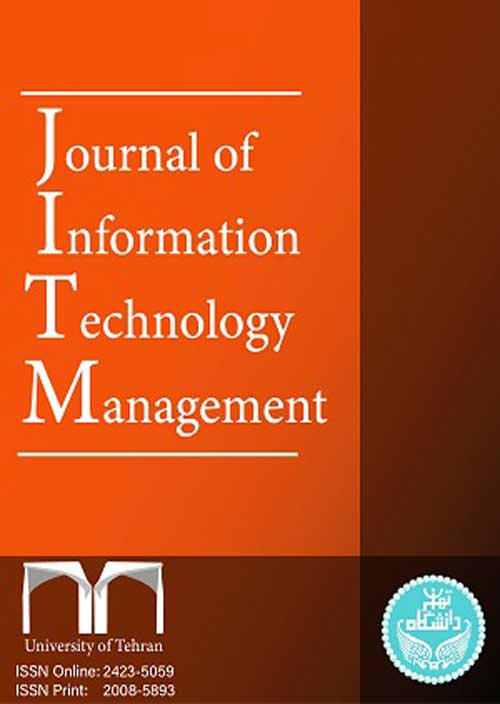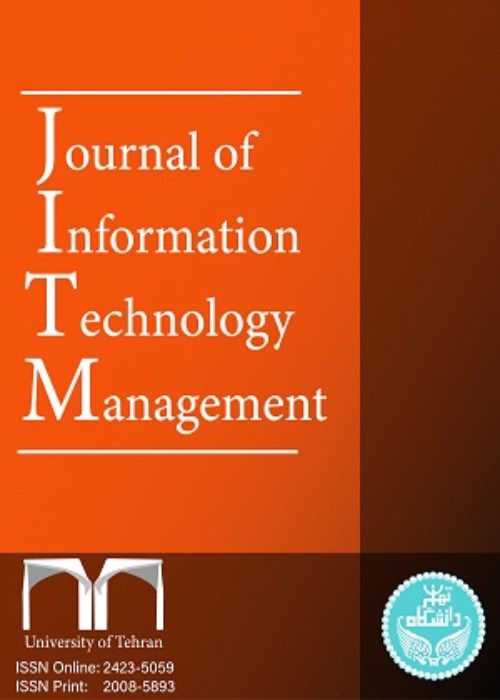فهرست مطالب

Journal of Information Technology Management
Volume:13 Issue: 2, Spring 2021
- Big Data Analytics and Management in Internet of Things
- تاریخ انتشار: 1400/02/11
- تعداد عناوین: 9
-
-
Pages 1-5
The Special Issue of the Journal of Information Technology Management (JITM) is publishing very selective papers on information management, Internet of Things (IoT), Algorithms, Quality of Service (QoS),Tourists Perception, Technology in higher education, integrated systems, enterprise management, Self-Service Technology (SST), cultural thoughts, strategic contributions, management information systems, and cloud computing. We received numerous papers for this special issue but after an extensive peer-review process, eight papers were finally selected for publication. In the digital age, the management of electronic archives became a trend as well as the focus of management development in many institutions.
Keywords: Big data, Internet of Things, Machine learning, technology, Education, Fraudulent activities -
Pages 6-20
Sentiment Analysis or opinion mining is NLP's method to computationally identify and categorize user opinions expressed in textual data. Mainly it is used to determine the user's opinions, emotions, appraisals, or judgments towards a specific event, topic, product, etc. is positive, negative, or neutral. In this approach, a huge amount of digital data generated online from blogs and social media websites is gathered and analyzed to discover the insights and help make business decisions. Social media is web-based applications that are designed and developed to allow people to share digital content in real-time quickly and efficiently. Many people define social media as apps on their Smartphone or tablet, but the truth is, this communication tool started with computers. It became an essential and inseparable part of human life. Most business uses social media to market products, promote brands, and connect to current customers and foster new business. Online social media data is pervasive. It allows people to post their opinions and sentiments about products, events, and other people in the form of short text messages. For example, Twitter is an online social networking service where users post and interact with short messages, called "tweets." Hence, currently, social media has become a prospective source for businesses to discover people's sentiments and opinions about a particular event or product. This paper focuses on the development of a Multinomial Naïve Bayes Based social media data emotion analyzer and sentiment classifier. This paper also explains various enriched methods used in pre-processing techniques. This paper also focuses on various Machine Learning Techniques and steps to use the text classifier and different types of language models.
Keywords: Machine learning, Multinomial naive bayes, Emotion analysis, Language models, Opinion Mining (OM), Sentiment Analysis (SA), Twitter -
Pages 21-35
As electronic commerce has gained widespread popularity, payments made for users' transactions through credit cards also gained an equal amount of reputation. Whenever shopping through the web is made, the chance for the occurrence of fraudulent activities are escalating. In this paper, we have proposed a three-phase scheme to detect fraudulent activities. A profile for the card users based on their behavior is created by employing a machine learning technique in the second phase extraction of a precise communicative pattern for the card users depending upon the accumulated transactions and the user's earlier transactions. A collection of classifiers are then trained based on all behavioral pattern. The trained collection of classifiers are then used to detect the fraudulent online activities that occurred. If an emerging transaction is fraudulent, feedback is taken, which resolves the drift's difficulty in the notion. Experiments performed indicated that the proposed scheme works better than other schemes.
Keywords: Electronic Commerce, Credit card, Machine learning, Transactions, Classifiers, Fraudulent activities -
Pages 36-53
The Internet of things has become an interesting area of research in the last few years due to its ability to make human life simple and easier. Quality of Services (QoS) has gained a lot of importance due to the increasing popularity of the technology. QoS metrics help the IoT users to understand and express their requirements for the selection of services provided by IoT. Researchers in this field have come up with different types of architectures to provide a better view and define all the functions of the technology. In this paper, we have defined a few of the architectures and QoS metrics related to these architectures.
Keywords: The Internet of things, Tiered architecture, Service-oriented, Microservice, quality of service -
Pages 54-67In the current paper, we have assimilated fuzzy techniques and optimization techniques, namely differential evolution, to put forward a modern archive-based fuzzy evolutionary algorithm for multi-objective optimization using clustering. The current work account for the application of a cluster associated approach. Specific quantitative cluster validity measures, i.e., J-measure and Xie-Beni, have been referenced to carry out the appropriate partitioning. The proposed algorithm introduces a new form of strategy which attempts to benefit the feasible search domain of the algorithm by minimizing the analysis and exploration of less beneficial search scope. This clustering method yields a group of trade-off solutions on the ultimate optimal pare to front. Eventually, these solutions are united and maintained in an archive for further evaluation. The current work summarizes and organizes an archive concerned with excellent and diversified solutions in an effort to outline comprehensive non-dominated solutions. The degree of efficiency is revealed with respect to partitioning on gene expression and real-life datasets. The proposed algorithm seeks to reduce the function assessment analysis and maintains a very small working population size. The effectiveness of the proposed method is presented in comparison with some state-of-art methods.Keywords: Multi-objective optimization, Clustering, Differential Evolution, Evolutionary algorithm, Euclidean based distance, Gene expression data
-
Pages 68-91Opportunistic networks in the Internet of Things (IoT) scenario, also known as OppIoT, espouse IoT devices interactions opportunistically in order to improve connectivity, the lifetime of the network, and network reliability. An increase in opportunistic utilization is fostered by IoT applications to find communication opportunities whenever possible to route and deliver data efficiently. In this opportunistic scenario, devising an efficient path for data delivery is a challenging work due to uncertainty in the connection between the nodes and the selection of intermediate forwarder nodes for data delivery towards the destination. Considering the scenario of uncertainty in device location and exploiting IoT devices opportunistically, this paper propounds a routing algorithm for OppIoT called Hybrid Multi-Copy Routing Algorithm (HMCRA). The proposed algorithm finds potential forwarder nodes by using fuzzy logic wherein residual energy, distance, and speed of the nodes are considered as input values while preparing fuzzy rules. Genetic Algorithm (GA) is considered along with fuzzy logic to select an efficient path for data delivery. In GA, the delay is taken as the fitness function to select a reliable path for data delivery. Simulation results of the proposed algorithm perform well in contrast with relative existing routing algorithms with respect to latency, overhead ratio, delivery probability, and hop count. The work uniqueness lies in the selection of potential nodes and finding path having less hop count in an opportunistic IoT network scenario.Keywords: boundary, Fitness function, Fuzzy logic, Genetic Algorithm, IOT, Multi-copy routing
-
Pages 92-110
Destination Image as a development which comprises of interrelated assessments converged with general impressions and convictions dependent on data preparing from an assortment of sources after some time; little research has concentrated on picture arrangement corresponding to this kind of goal, this article explores the mediating role of Online Image on the connection between E-WOM and E-service quality, E-satisfaction, E- trust The result of Structural equation Modelling (AMOS) path analysis affirmed that estimation model fulfilled the necessity and evidence the solidness of things, builds and correlation. All the four conditions for estimation model was met: things stacking above 0.7; unwavering composite quality (CR) above 0.7; Average Variance Extraction (AVE) above 0.5. The scholastics and industry will profit by the usage of this examination. Likewise, the tourist industry division can draw from these outcomes as references and proposals inside the impediments of the study. Future research headings were proposed to deal with the restrictions.
Keywords: E-Word of Mouth, E-Trust & E-Service Quality, Online Destination Image -
Pages 111-132
Multicasting is an important operation in software-defined wireless sensor networks (SDWSNs). In this operation, a group of nodes specified by their unique node identification numbers is supposed to receive the same multicast message at the approximately same time, if possible. These nodes are termed as multicast members or multicast destinations. They need not be physically close to one another to form a group. The present article proposes an energy-efficient scheduler exclusively for multicast operation in the SDWSN environment. Based on the advantages provided by underlying network architecture, a router can efficiently schedule multicast packets belonging to various multicast sessions. This promotes greenery in the network and significantly increases the packet delivery ratio. These claims are supported and justified by the experimental results presented in this paper. As far as the authors know, there is no multicast packet scheduler in the literature of wireless sensor networks or WSN. SDWSN is a more advanced version, and no multicast protocol has yet been proposed for these kinds of networks. Therefore, while designing the present fuzzy scheduler, we kept in mind all standard multicast protocols in the WSN environment.
Keywords: Energy Efficiency, Fuzzy scheduler, Multicasting, Software-defined wireless sensor networks, urgency -
Pages 133-142
Learning effective segment depictions and resemblance measures are fundamental to the recuperation execution of a substance based picture recuperation (CBIR) structure. Regardless of wide research tries for a significant long time, it stays one of the most testing open gives that broadly impedes the achievements of real-world CBIR structures. The key test has been credited to the extraordinary "semantic hole" subject that happens between low-level photo pixels got by technologies and raised close semantic thoughts saw by a human. Among various techniques, AI has been successfully analyzed as a possible course to interface the semantic gap in the whole deal. Impelled by late triumphs of significant learning techniques for PC vision and various applications, in this paper, we try to address an open issue: if significant learning is a longing for spreading over the semantic gap in CBIR and how much updates in CBIR endeavors can be cultivated by exploring the front line significant learning methodology for learning feature depictions and likeness measures. Specifically, we explore a structure of significant learning with application to CBIR assignments with a wide game plan of definite examinations by investigating front line significant learning methodologies for CBIR endeavors under moved settings. From our exploratory examinations, we find some encouraging results and compress some huge bits of information for upcoming research.
Keywords: CBIR, Content, Context, Machine learning, Deep learning


